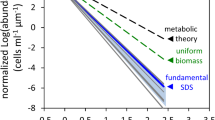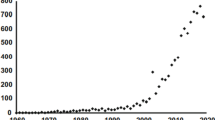Abstract
This paper summarises the outcomes of the 13th Workshop of the International Association of Phytoplankton Taxonomy and Ecology (IAP). The authors mostly addressed their contributions on the following topics: the effect of trophic state on the attainment of a steady-state; the establishment of equilibria in deep and shallow lakes; the role of spatial heterogeneity, disturbance, and stress in the establishment of equilibrium assemblages; the mechanisms leading to the steady state; the frequency and longevity of equilibrium phases, and the role of morphological and physiological plasticity of phytoplankton in maintaining the (apparently) same populations under different environmental conditions. The composition of steady-state assemblages is compared to that of phytoplankton functional groups (coda). Those functional associations recognised as steady-state assemblages appear to be strongly K-determined in many instances.
Similar content being viewed by others
References
Albay, M. & R. Akcaalan, 2003. Factors determining the phytoplankton steady state assemblages in a drinking-water reservoir (Ömerli reservoir, Istanbul). Hydrobiologia 502 (Dev. Hydrobiol. 172): 85–95.
Allen, T. F. H. & Starr, T. B. 1982: Hierarchy: perspectives for ecological complexity. University of Chicago Press, Chicago.
Allende, L. & I. Izaguirre, 2003. The role of physical stability on the establishment of steady state in the phytoplankton community of two Maritime Antarctic lakes. Hydrobiologia 502 (Dev. Hydrobiol. 172): 211–224.
Barone, R. & L. Naselli-Flores, 2003. Distribution and seasonal dynamics of cryptomonads in Sicilian water bodies. Hydrobiologia 502 (Dev. Hydrobiol. 172): 325–329.
Borics G., B. Tóthmérész, I. Grigorszky, J. Padisák & G. Várbíró, 2003. Algal assemblage types of bog-lakes in Hungary and their relation to water chemistry, hydrological conditions and habitat diversity. Hydrobiologia 502 (Dev. Hydrobiol. 172): 145–155.
Chorus, I. & G. Schlag, 1993. Importance of intermediate disturbances for the species composition and diversity of phytoplankton in two very different Berlin lakes. Hydrobiologia 249: 67–92.
Clements, F. E. 1916. Plant Succession: an Analysis of the Development of Vegetation. Carnegie Inst. Washington Publ. 242: 1-517.
Dokulil M. & K. Teubner, 2003. Steady state phytoplankton assemblages during thermal stratification in deep alpine lakes. Do they occur? Hydrobiologia 502 (Dev. Hydrobiol. 172): 65–72.
Flaim, G., E. Rott, F. Corradini & G. Toller, 2003. Long-term trends in species composition and diurnal migration of dinoflagellates in Lake Tovel (Trentino, Italy). Hydrobiologia 502 (Dev. Hydrobiol. 172): 357–366.
Gaedeke, A. & U. Sommer, 1986. The influence of periodic disturbances on the maintenance of phytoplankton diversity. Oecologia 71: 98–102.
Harris, G. P. 1986: Phytoplankton Ecology. Strucure, function and fluctuation. Chapman and Hall, London.
Huszar, V., C. Kruk & N. Caraco, 2003. Steady-state assemblages of phytoplankton in four temperate lakes (NE USA). Hydrobiologia 502 (Dev. Hydrobiol. 172): 97–109.
Komárková, J. & R. Tavera, 2003. Steady state of phytoplankton assemblage in tropical Lake Catemaco (Mexico). Hydrobiologia 502 (Dev. Hydrobiol. 172): 187–196.
Krebs, C. H., 2001. Ecology. Experimental Analysis of Distribution and Abundance. Addison Wesley, San Francisco, pp. 695.
Leitão, M., S. Morata, S. Rodriguez & J. P. Vergon, 2003. The effect of perturbations on phytoplankton assemblages in a deep reservoir (Vouglans, France). Hydrobiologia 502 (Dev. Hydrobiol. 172): 73–83.
Mischke U. & B. Nixdorf, 2003. Equilibrium phase conditions in shallow German lakes: How cyanoprokaryota species establish a steady state phase in late summer. Hydrobiologia 502 (Dev. Hydrobiol. 172): 123–132.
Morabito G., A. Oggioni & P. Panzani, 2003. Phytoplankton assemblage at equilibrium in large and deep subalpine lakes: a case study from Lago Maggiore (N. Italy). Hydrobiologia 502 (Dev. Hydrobiol. 172): 37–48.
Naselli-Flores, L. & R. Barone, 2003. Steady-state assemblages in a Mediterranean hypertrophic reservoir. The role of Microcystis eco-morphological variability in maintaining an apparent equilibrium. Hydrobiologia 502 (Dev. Hydrobiol. 172): 133–143.
Nixdorf, B., U. Mischke & J. Rucker, 2003. Phytoplankton assemblages and steady state in deep and shallow eutrophic lakes - an approach to differentiate the habitat properties of Oscillatoriales. Hydrobiologia 502 (Dev. Hydrobiol. 172): 111–121.
O'Farrell, I., R. Sinistro, I. Izaguirre & F. Unrein, 2003. Do steadystate assemblages occur in shallow lentic environments from wetlands? Hydrobiologia 502 (Dev. Hydrobiol. 172): 197–209.
Ortega-Mayagoitia, E., C. Rojo & M. A. Rodrigo, 2003. Controlling factors of phytoplankton assemblages in wetlands: an experimental approach. Hydrobiologia 502 (Dev. Hydrobiol. 172): 177–189.
Padisák J., 2003. Estimation of minimum sedimentary inoculum (akinete) pool of Cylindrospermopsis raciborskii: a morphology and life-cycle based method. Hydrobiologia 502 (Dev. Hydrobiol. 172): 389–394.
Padisák, J., G. Borics, G. Fehér, I. Grigorszky, I. Oldal, A. Schmidt & Z. Zámbóné-Doma, 2003. Dominant species, functional assemblages and frequency of equilibrium phases in late summer phytoplankton assemblages in Hungarian small shallow lakes. Hydrobiologia 502 (Dev. Hydrobiol. 172): 157-168.
Peters, R. H., 1991. A Critique for Ecology. Cambridge University Press, Cambridge, pp. 366.
Reynolds, C. S. 1997. Vegetation Processes in the Pelagic: A Model for Ecosystem Theory. Ecology Institute, Oldendorf/Luhe.
Rojo C. & M. Álvarez-Cobelas, 2003. Are there steady state phytoplankton assemblages in the field? Hydrobiologia 502 (Dev. Hydrobiol. 172): 3-12.
Salmaso N., 2003. Life strategies, dominance patterns and mechanisms promoting species coexistence in phytoplankton communities along complex environmental gradients. Hydrobiologia 502 (Dev. Hydrobiol. 172): 13-36.
Scheffer, M., 1998. Ecology of Shallow Lakes. Chapman and Hall, London, pp. 257.
Sommer, U., J. Padisák, C. S. Reynolds & P. Juhász-Nagy 1993: Hutchinson's heritage: the diversity-disturbance relationship in phytoplankton. Hydrobiologia 249: 1-7.
Stoyneva, M., 2003. Steady state phytoplankton assemblages in shallow Bulgarian wetlands. Hydrobiologia 502 (Dev. Hydrobiol. 172): 169-176.
Teubner, K., M. Tolotti, S. Greisberger, He. Morscheid, M. T. Dokulil & H. Morscheid, 2003. Steady state phytoplankton in a deep pre-alpine lake: Species and pigments of epilimnetic versus metalimnetic assemblages. Hydrobiologia 502 (Dev. Hydrobiol. 172): 49-64.
Tolotti, M., H. Thies, M. Cantonati, C. M. E. Hansen & B. Thaler, 2003. Flagellate algae (Chrysophyceae, Dinophyceae, Cryptophyceae) in 48 high mountain lakes of the northern and southern slope of the eastern Alps: Biodiversity, distribution of taxa, and their driving variables. Hydrobiologia 502 (Dev. Hydrobiol. 172): 331-348.
Whittaker 1975: Communities and Ecosystems. Macmillan, New York.
Whittaker, R. H. & Levin, S. A. 1977: The role of mosaic phenomena in natural communities. Theor. Popul. Biol. 12: 117-139.
Willén, E., 2003. Dominance patterns of planktonic algae in Swedish forest lakes. Hydrobiologia 502 (Dev. Hydrobiol. 172): 315-324.
Author information
Authors and Affiliations
Rights and permissions
About this article
Cite this article
Naselli-Flores, L., Padisák, J., Dokulil, M.T. et al. Equilibrium/steady-state concept in phytoplankton ecology. Hydrobiologia 502, 395–403 (2003). https://doi.org/10.1023/B:HYDR.0000004297.52645.59
Issue Date:
DOI: https://doi.org/10.1023/B:HYDR.0000004297.52645.59




